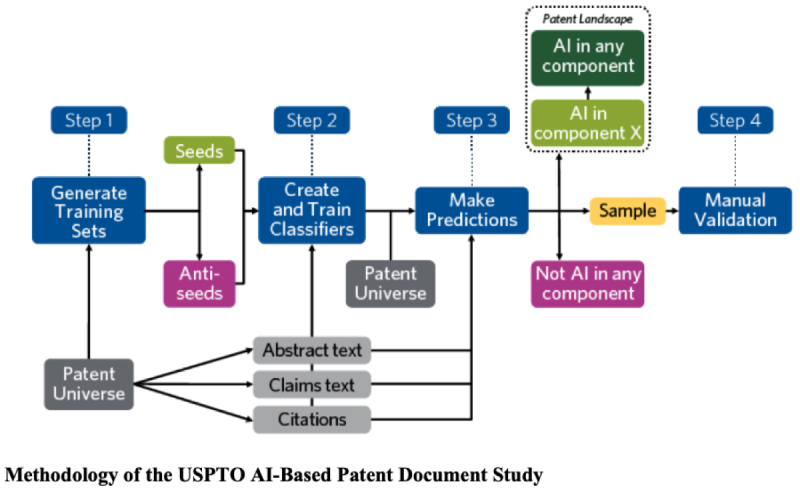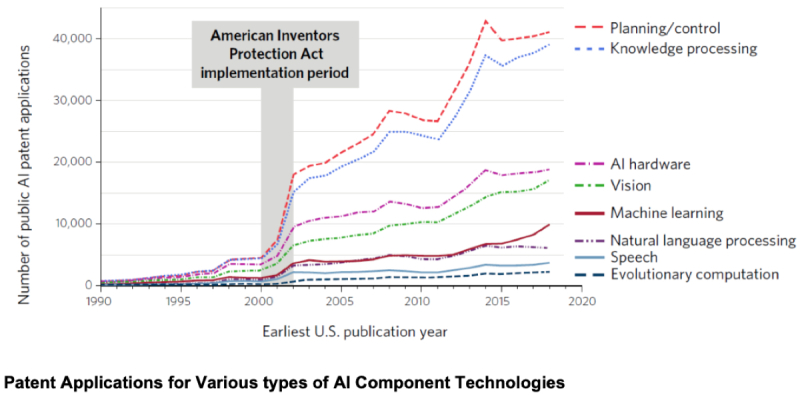Yesterday, the U.S. Patent and Trademark Office released a study entitled "Inventing AI", which highlights the increasing prevalence of artificial intelligence (AI)-based patent applications in the U.S. over the past few decades. The study, released by the Office of the Chief Economist of the USPTO, surveyed publicaly available granted U.S. patents and U.S. patent application pre-grant publications (PGPub) published from 1976 through 2018.
In a very "meta" analysis method, the study authors utilized a machine learning neural network classification model to identify patent documents relevant to AI. The author's neural network classifier identified patent documents that fit into one or more of eight "AI component technologies": Knowledge processing, Speech, AI hardware, Evolutionary computation, Natural language processing, Machine learning, Vision, and Planning and control. Once the relevant patent landscape was identified, the study examined various patent trends and diffusion across technologies, inventor-patentees, organizations, and geography.
 Source: https://www.uspto.gov/sites/default/files/documents/OCE-ai-supplementary-materials.pdf
Source: https://www.uspto.gov/sites/default/files/documents/OCE-ai-supplementary-materials.pdf
Interestingly, the study utilized text from patent document abstracts as well as from the corresponding claims to train its classifier system while previous research in this area had focused on the abstract text only. In describing its methodology, the authors claim that their machine learning model classifier achieved results comparable to that of a manual evaluator and more than 92% accurate in properly classifying patent documents into AI component technologies.
One of the main themes of the study is that AI-based patents are diffusing throughout the U.S. patent system. For example, while it may be perhaps unsurprising that the number of AI patent applications has increased by more than 100% between 2002 and 2018, the study found that the share of applications relating to AI grew from 9% to nearly 16% of all patent applications over that time period. That is, as of 2018, the study suggests that almost one out of every six patent applications relates to at least one AI component technology. Furthermore, the authors indicate that AI-related patent documents appeared in about 9% of all technology subclasses in 1976 while such documents spread to over 42% of all technology subclasses by 2018.

Source: https://www.uspto.gov/sites/default/files/documents/OCE-DH-AI.pdf
Infographics from the USPTO study indicated that AI-based technologies are also diffusing geographically throughout the U.S. For example, the study compared the location of inventor-patentees between two periods: 1976-2000 and 2001-2018, which indicates substantial growth of AI-based patenting in the Midwest and other "non-traditional" technology hubs.
Furthermore, the USPTO study found that a greater variety of companies seek to patent AI-based technologies. For example, while most of the group of the top 30 AI-based patent owners are in the information and communications technology (ICT) sector, AI technologies are now being increasingly adopted and patented by companies in other technology sectors, including multi-sector conglomerates (General Electric), aerospace (Boeing), and financial (Bank of America).
In its role to advise Under Secretary of Commerce for Intellectual Property and Director of the USPTO Andrei Iancu on the economic implications of policies and programs affecting the U.S. intellectual property system, the Office of the Chief Economist apparently believes that AI-based patents are poised to continue their dramatic expansion. In closing, the study authors state that:
Whether AI turns out to be as revolutionary as electricity or the semiconductor depends, in part, on the ability of innovators and firm to successfully incorporate AI inventions into existing and new products, processes, and services. Our results suggest that AI has this potential.
Regardless of whether AI will become as revolutionary as electricity, however, it is clear that AI-based patents will remain an important part of the U.S. patent landscape going forward.
For additional information, please see:
• United States Patent and Trademark Office, Office of the Chief Economist, "Inventing AI; Tracing the diffusion of artificial intelligence with U.S. patents" Number 5, October 2020. https://www.uspto.gov/sites/default/files/documents/OCE-DH-AI.pdf
• United States Patent and Trademark Office, Office of the Chief Economist, "Supplementary Material; Inventing AI: Tracing the diffusion of artificial intelligence with U.S. patents" Number 5, October 2020. https://www.uspto.gov/sites/default/files/documents/OCE-ai-supplementary-materials.pdf
• Aaron Abood and Dave Feltenberger, "Automated patent landscaping" Artificial Intelligence and Law, June 2018. https://dl.acm.org/doi/abs/10.1007/s10506-018-9222-4